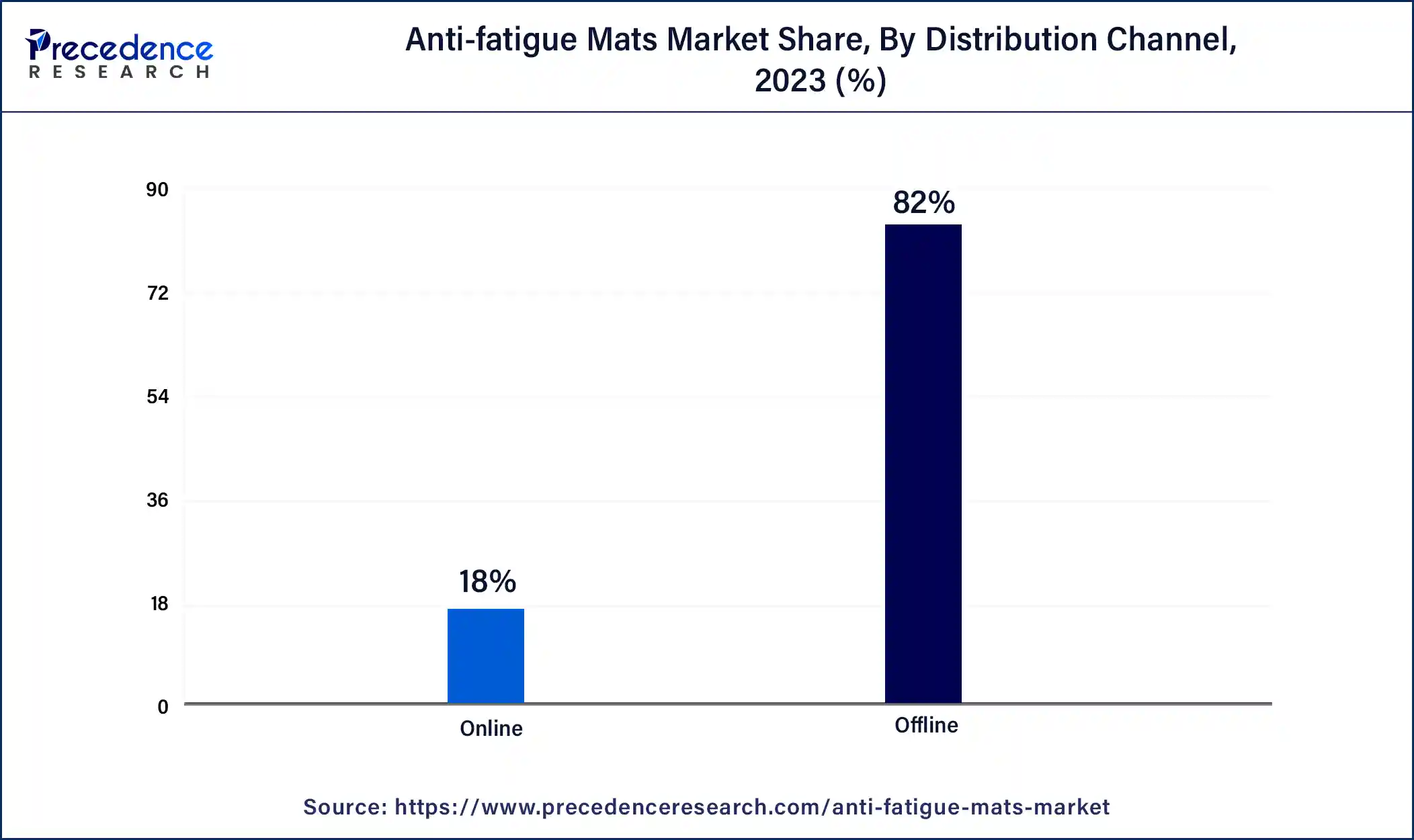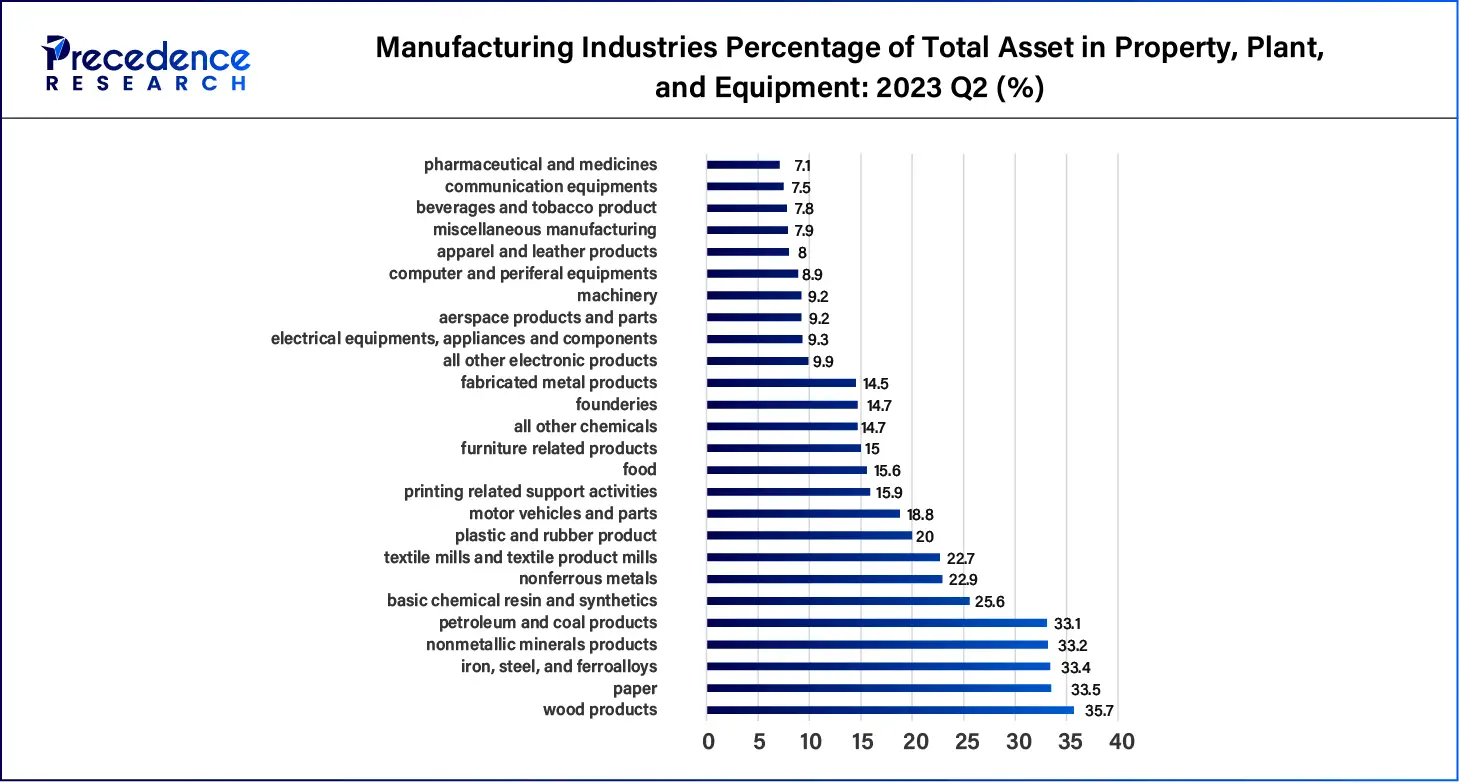List of Contents
What is the Anti-fatigue Mats Market Size?
The global anti-fatigue mats market size is calculated at USD 1.99 billion in 2025 and is predicted to increase from USD 2.09 billion in 2026 to approximately USD 3.09 billion by 2034, growing at a CAGR of 5.04% over the forecast period 2025 to 2034. The North America anti-fatigue mats market size reached USD 740 million in 2024. The increasing demand for shockproof mats in the workplace to reduce pain and foot discomfort while working is fueling the growth of the anti-fatigue mats market.

Anti-fatigue Mats Market Key Takeaways
- The global anti-fatigue mats market was valued at USD 1.80 billion in 2024.
- It is projected to reach USD 3.09 billion by 2034.
- The anti-fatigue mats market is expected to grow at a CAGR of 5.04% from 2025 to 2034.
- North America dominated the anti-fatigue mats market with the largest market share of 39% in 2024.
- Asia Pacific is projected to grow at a notable CAGR of 5.93% during the forecast period.
- By application, the industrial segment generated the biggest market share of 53% in 2024.
- By application, the commercial segment is expected to grow at a solid CAGR of 5.72% over the studied period of 2025 to 2034.
- By distribution channel, the offline channel segment contributed the highest market share of 82% in 2024.
- By distribution channel, the online segment registers a remarkable CAGR of 6.03% over the forecast period.
How Can AI Impact the Anti-fatigue Mats Market?
The evaluation of AI in the industrial accessories and manufacturing industries is revolutionizing the industrial sector. It improves operation and productivity by streamlining management in the industries. The development of Industry 4.0 causes the integration of AI, IoT, and automation in industrial work. A number of industry leaders are adopting AI in industrial accessories to predict equipment failures and maintenance schedules and improve efficiency. The inclination towards smart anti-fatigue mats over traditional mats due to their higher reliability by the industries for improving the health of workers and enhancing productivity.
Anti-fatigue Mats Market Overview: The Market Snapshot
The anti-fatigue mats are the products used to reduce the fatigue and stress of the workers or laborers caused by standing on hard or tense surfaces for a longer period of time. These types of mats are used to reduce food and lower limb disorders and pain due to standing in a steady position for a longer period of time. Footwear, flooring, and working positions are the leading causes of stress and discomfort in the legs and limbs while working. The discomfort, pain, stress, and disorders can directly affect the production quantity and quality. Anti-fatigue mats are adopted by a number of industrial and commercial sectors to provide relaxation to workers. The anti-fatigue mats are made of different materials such as carpeting materials, rubber, wood, and vinyl. The increasing adaptation of the anti-fatigue mats to improve working productivity is driving the growth of the anti-fatigue mats market.
Anti-fatigue Mats Market Growth Factors
- Rising population: The increasing population and the increasing demand for industrialization and employee employment in industries are accelerating the demand for anti-fatigue mats.
- Increasing industrial development: The rising demand and the development of end-use industries such as automotive, construction, machinery, electronics, healthcare, aerospace, manufacturing, and others.
- Increased working hours: The rise in the working hours creates a hectic schedule and stress for the workers and impacts the health of industrial and commercial workers who anticipated the increased demands for the anti-fatigue mats.
- Government intervention: The stringent government regulations on employee welfare and health concerns during working hours by the various regional governments are accelerating the growth of the anti-fatigue mats market.
- Rise in infrastructure standards: With the increasing concern about the workplace environment providing safety and reducing stress levels, market leaders are spending highly on the improvement of industrial or commercial places.
Anti-fatigue Mats Market Trends
First Mats launched the Hygienic Anti-Fatigue Mats; the mats are specially designed for healthcare, sterile environments, and food production facilities. The material mats can be cleaned and sterilized by steam. These mats will provide both hygiene and comfort for employees in sterile environments.
Anti-fatigue Mats Market Outlook: The Emerging Anti-fatigue Solutions
- Industry Growth Overview: Increasing awareness of workplace ergonomics and safety regulations is contributing to the industry growth.
- Major Investors: Large institutional asset managers are the major investors in the market.
- Startup Ecosystem: Integration of smart technologies to provide real-time data and development of customizable modular solutions is the focus of the startup ecosystems.
Market Scope
| Report Coverage | Details |
| Market Size by 2034 | USD 3.09 Billion |
| Market Size in 2025 | USD 1.99 Billion |
| Market Size in 2026 | USD 2.09 Billion |
| Market Growth Rate from 2025 to 2034 | CAGR of 5.04% |
| Largest Market | North America |
| Base Year | 2024 |
| Forecast Period | 2025 to 2034 |
| Segments Covered | Application, Distribution Channel and Regions |
| Regions Covered | North America, Europe, Asia-Pacific, Latin America and Middle East & Africa |
Market Dynamics
Drivers
The rising concern about the employees' health
The increasing population around the globe is driving the demands for end-use industries such as healthcare, manufacturing, consumer electronics, automotive, and others, which are driving the industrial infrastructure and worker numbers. These industries are working continuously for non-stop production, which impacts the health of workers who are continuously working in the same position for long hours, which affects the production capacity and quality. The rising concern about industrial and commercial workers' health due to stress, pain, and foot discomfort drives the adoption of anti-fatigue mats. These mats help in alleviating foot discomfort and pain by providing cushioning effects, which help in reducing foot fatigue. The increasing adoption of anti-fatigue mats for providing relief from foot fatigue and other hip-related stress contributed to the increasing demand for anti-fatigue mats.
Restraints
Fluctuating quality
The fluctuating quality of the raw material hampers the quality of the mats, and substandard material results in quick wearing out and results in frequent replacements, which hampers the growth of the market.
Opportunity
Sustainability in anti-fatigue mats
There is a rising concern over environmental pollution and global warming due to non-degradable material products. The rising awareness of carbon footprints is driving the adoption of sustainable and biodegradable materials for the manufacturing of industrial machinery and other accessories. The rising development in the eco-friendly material for the production of the anti-fatigue mats. The rising adaptation of biodegradable materials such as jute, coir, and cotton for the production of anti-fatigue mats due to natural decomposition at the end of their lifecycle. The biodegrade option also offers attractive aesthetics and attracts eco-conscious consumers. The rising concern over the adoption of the bio-degradable material over the traditionally used material in the anti-fatigue mats
Application Insights
The industrial segment dominated the anti-fatigue mats market in 2024. The rising adoption of anti-fatigue mats in several industrial units provides comfort and reduces the stress of the long working labor force. The rising consumer base due to the rising population causes the increased development in industrialization and the demand for continuous production. The laborers continuously working in standing positions may cause severe health issues. The anti-fatigue mats help relieve the stress and fatigue caused by continuous work. The anti-fatigue mats are installed in the assembly lines to provide comfort and reduce physical stress while operating, which results in reduced chances of getting injured and helps improve productivity.
- As per the 29th edition of the International Yearbook of Industrial Statistics, the recent survey on global developments in industrial sectors is shared. There are 2.3% growth in industrial sectors globally. The manufacturing industry accounted for the largest growth, consisting of a 3.2% increase with the integration of the mining and utilities sectors.
The commercial segment is anticipated to grow at a significant rate in the anti-fatigue mats market over the studied period of 2023 to 2034. The rise in the global population and the increasing disposable income in the population are causing lifestyle preferences, and the rise in the consumer segment is driving the demand for commercialization across the countries. The increasing adoption of anti-fatigue mats in commercial settings such as hotel kitchens, hospitals, pharmaceuticals, malls, and other commercial spaces for workers who are standing for extended periods of work. Anti-fatigue mats are highly adopted in commercial settings to provide comfort, which enhances productivity.
Distribution Channel Insights
The sales through offline channel segment led the anti-fatigue mats market in 2024. The increasing adoption of the offline channel for the buying of the product with quality checks and value-added services with the product is driving the demand for the segment. The rising availability of anti-fatigue mats with a variety of brands in retail stores and other offline channels. They provide after-sales services while using anti-fatigue mats. Offline stores are giving great discounts and other offers associated with the bulk buying of anti-fatigue mats by industries and commercial offices such as hotels, hospitals, malls, and others.

The sales through online channel segment is anticipated to witness significant growth in the anti-fatigue mats market over the forecast period. The younger population is increasing, internet penetration is increasing among individuals, and e-commerce sectors are rising with the availability of different brands. The online sales channels are mainly divided into two types: buying products from the e-commerce sector or directly from the company's website. The online sales channel provides a wide variety of products with great discounts and offers, as well as doorstep delivery and easy return and replacement policies if the product is defective, which attracts the consumer to the online sales channel segment.
Regional Insights
U.S. Anti-fatigue Mats Market Size and Forecast 2025 to 2034
The U.S. anti-fatigue mats market size is exhibited at USD 580 million in 2025 and is projected to surpass around USD 920 million by 2034, poised to grow at a CAGR of 5.28% from 2025 to 2034.

Advanced Industries Drives North America
North America dominated the anti-fatigue mats market in 2024. The growth of the market is attributed to the availability of a well-developed industrial infrastructure that drives the demand for anti-fatigue mats for worker comfort and to reduce stress due to continuous working hours. Regional countries like the United States and Canada have developed industrial and commercial infrastructure, and stringent government policies on labor welfare are contributing to the increased demand for anti-fatigue mats. The United States spends a significant amount on lifestyle management and healthcare at home, and the workplace and employers are spending an amount on employee comfort, which collectively accelerates the growth of the anti-fatigue mats market in the region.

- OSHA administers the Occupational Safety and Health (OSH) Act. The budget for the OSHO for FY2023 is $632,000,000, and FY2022 is $612,000,000.
- As per the OSHO report, the total number of federal inspections in FY 2023 is 34,267.
- 5,486 fatal work injuries happened in 2022 (3.7 fatalities per 100,000 full-time equivalent workers.

Rapid Urbanization Boosts the Asia Pacific
Asia Pacific is expected to have significant growth during the forecast period. The growth of the market is owing to the rising urbanization and industrial and commercial development, which boosts the demand for anti-fatigue mats. The rising consumer base in countries like India, China, and Japan is increasing the demand for industries to cater to the rising demand for end products. Additionally, the rising concern about the employees' health is driving the growth of the anti-fatigue mats market in the region.
- The manufacturing industry of India generated 16-17% of India's GDP pre-pandemic and is estimated to be one of the fastest-growing industries. India has the capacity to export products worth US$ 1 trillion by 2030 and is expected to become the major global manufacturing hub.
- Over 27.3 million workers and 17% of the nation's GDP, the manufacturing industry plays a significant role in the Indian economy. With the implementation of various policies and programs, the government of India is expected to reach 25% of the economy's output from manufacturing by 2025.
- With the increasing global demand and government initiatives, India's mobile phone manufacturing industry is expected to create 150,000 to 250,000 direct and indirect jobs within the next 12-16 months.
- The manufacturing GVA at its current price in the first quarter of FY24 was expected at US$ 110.48 billion.
Major Producers Fuels India
The presence of major producers of raw materials in India is driving the development of anti-fatigue mats. Additionally, the companies are developing affordable solutions, which is attracting the consumers and leading to increased exportation, which is enhancing the market growth.
Europe Embraces Stringent Regulations
Europe is expected to grow significantly in the anti-fatigue mats market during the forecast period, due to stringent regulations. They are increasing the use of these mats to meet the workplace safety regulations, boosting their development and innovations. Moreover, the growing health awareness is also increasing their use, promoting the market growth.
Safety Regulations Shape the UK
Growth in safety regulations is increasing the use of anti-fatigue mats in the UK. The presence of advanced industries is driving their development and innovations to enhance safety and productivity. The growing e-commerce is also increasing its availability, driving its adoption rates.
South America Driven by Rapid Industrialization
South America is expected to grow in the anti-fatigue mats market during the forecast period, due to rapid industrialization. This is increasing the demand for ergonomic flooring, which is enhancing the development of anti-fatigue mats. The growing awareness and safety regulations are also increasing their use. Additionally, growing healthcare services are also increasing their use, contributing to the market growth.
Value Chain Analysis
- Product Conceptualization and Design
Product conceptualization and design of anti-fatigue mats involves applying ergonomics principles to develop cushioned surfaces for subtle foot and leg movements.
Key players: Wearwell, LLC, NoTrax. - Raw Material Procurement
Procurement of materials like natural and synthetic rubber, polyurethane foam, and polyvinyl chloride is involved in the raw material procurement of anti-fatigue mats.
Key players: BASF, Lanxess. - End-of-Life Management
End-of-life management of anti-fatigue mats involves disposal in landfills due to a lack of specialized recycling infrastructure.
Key players: AcroMat, Wearwell
Anti-fatigue Mats Market Leaders: Key Players' Offering
- NoTrax: Cushion Trax and Sky Trax, and rubber matting are provided by the company.
- Wearwell, LLC: The company provides ErgoDeck, a corrugated matting diamond plate.
- Smart Step Flooring: Smart Step Mats are provided by the company.
- Durable Corporation: Anti-fatigue mats like urethane HD, work master, vinyl heavy duty diamond dek sponge, etc, are provided by the company.
- Cintas Corporation: The company offers Antifatigue mats.
Anti-fatigue Mats Market Companies
- NoTrax
- 3M Corporation
- Wearwell, LLC
- Smart Step Flooring
- Durable Corporation
- Cintas Corporation
- Euronics Industries Pvt Ltd.
- M+A Matting
- SmartCells USA
- UniFirst Corporation
Recent Developments
- In March 2024, Endeavour Group, partnering with the Amorim Cork and Save Our Soles, launched ReCORK Australia's only large-scale, natural cork stopper recycling program; these will cater to the recycling challenge associated with the natural cork stoppers while repurposing them into the usable and eco-friendly products.
- In February 2023, Wearwell launched the addition to its Wellness Mats range with the introduction of Smart Step anti-fatigue matting. The mats are made in the United States and are 100% made from durable polyurethane for long-lasting comfort and resilience.
Segments Covered in the Report
By Application
- Industrial
- Commercial
- Residential
By Distribution Channel
- Offline
- Online
By Geography
- North America
- Asia Pacific
- Europe
- Latin America
- Middle East & Africa
For inquiries regarding discounts, bulk purchases, or customization requests, please contact us at sales@precedenceresearch.com
Frequently Asked Questions
Ask For Sample
No cookie-cutter, only authentic analysis – take the 1st step to become a Precedence Research client